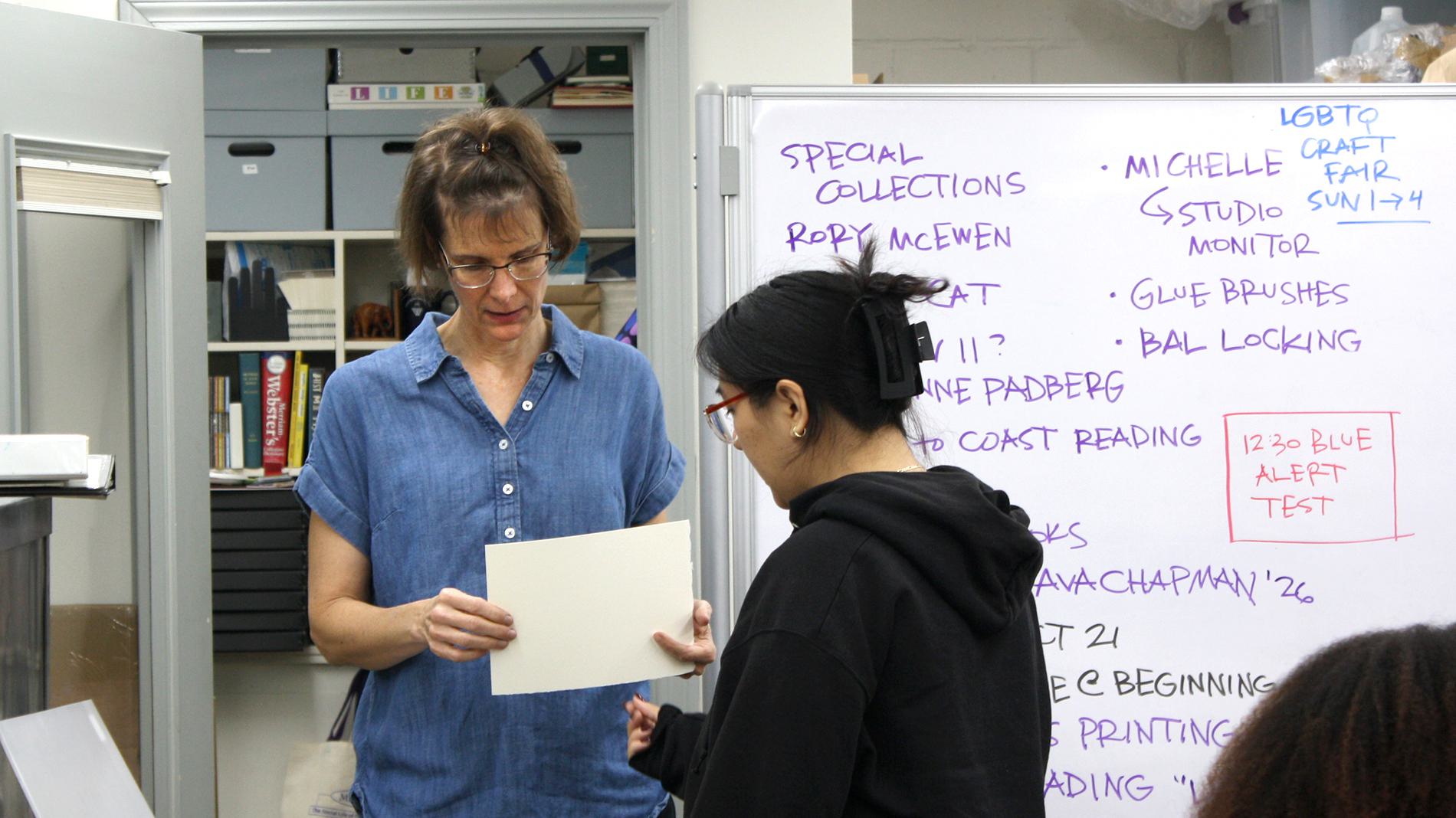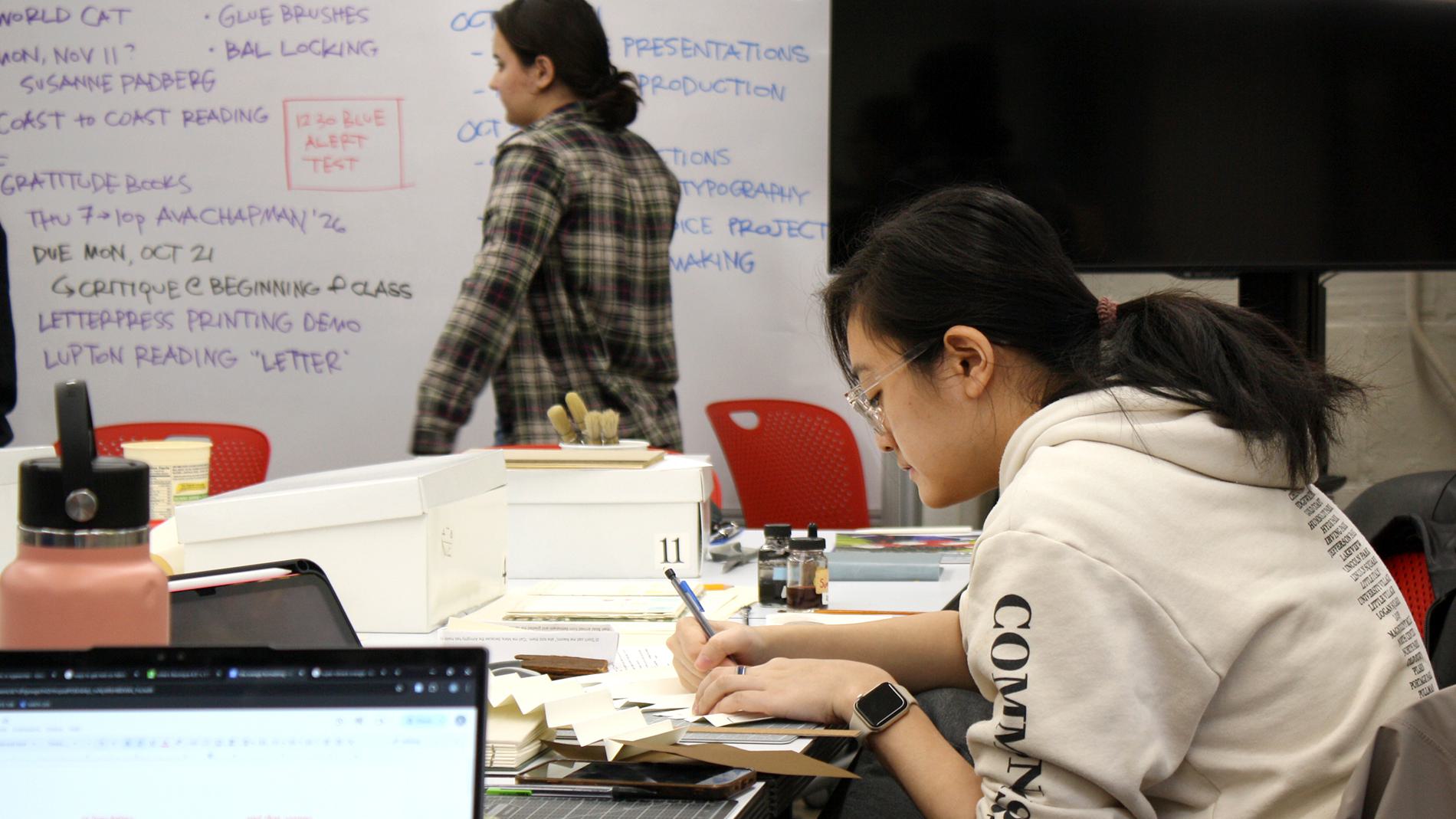The Wellesley College Book Arts Lab celebrated its 80th anniversary on September 26 with a gathering of alums, students, and professors at the Suzy Newhouse Center for the Humanities. All panelists and attendees, whether in person or virtual, contributed to a warm and inviting environment that served as an inspiration for those not already involved with the lab.
The book arts lab was founded in 1944, when rare books librarian Hannah French moved a 19th-century iron hand press into the basement of the Margaret Clapp Library. She envisioned Wellesley students learning to set type and print on the press to connect them more closely with the materials they studied in the College’s Special Collections. French’s plan was supported by then-President Mildred McAfee, with funding from Annis Van Nuys Schweppe, class of 1903, and the developmental assistance of French’s supervisor, Miss McCrum.
Since then, the lab has been housed on the fourth floor of the library, though it is living temporarily in Green Hall as Clapp is being renovated. “The small part of my career I have started, I owe to the fourth floor,” said Maggie Erwin ’23, curatorial assistant in the printing and graphic arts department of Houghton Library, who was a panelist at the event.
The book arts lab is designed for hands-on action and involvement. Students in the College’s book studies program learn to use the lab’s tools for letterpress printing, typography, bookbinding, papermaking, and more. The panelists at the anniversary event described the program as incredibly interdisciplinary and unlike any other literary or history-based activity. Most of them were introduced to the lab through on-campus jobs as student assistants, and consequently fell in love with the craft and continued to study it after Wellesley.

“Turning an ideological concept into a physicality is a wonderful art,” said Erwin. Mary French ’09, a book conservator, noted that in the digital age of e-books and audiobooks, nothing beats the texture, feel, and smell of a book: “Books engage most, if not all, of your senses.” Working with books slows you down and grounds you in the present, said Robin Siddall ’16, a printmaker and book artist, adding that “it was incredibly valuable to work with deliberation and intention—no shortcuts.”
Meredith Santaus ’16 works for Philip Salmon & Company, a rare books dealer in Boston that specializes in fine presses, artists’ books, illustration art, and literature, and she previously curated exhibitions for current book artists with Bromer Booksellers. “Whatever experience I have had with book arts at Wellesley forms a large part of my ability to converse with artists in their own language, and to relay that language to collectors,” Santaus said. And as panelist Alexander Brey, assistant professor of art, put it: “There’s such a beauty in how materials are a conversation.”
Though unable to attend the event, Nora Cornell ’25 is the College’s first book studies major—an independent major she created by combining her interests in English, history, and studio art. She said in a video about her pioneering major that she is confident in her ability to use this interdisciplinary degree after graduation.
Katherine Ruffin, director of the book studies program, said she’s seen her book arts students go on to become everything from cybersecurity experts to midwives. “It’s a spirit, it’s a way of doing things. It’s more than just a place,” she said of the lab. Ruffin cultivates a warm environment in the lab, supporting students and alums, maintaining the lab, teaching classes, and bringing the tight-knit network together. Siddall said, “The mentorship and active relationship-building that Katherine facilitates is a huge, huge part of how I have made my way down the path I am on. … [W]hat really spoke to me was the physical connection between knowing and making, and the relationships that derive from a shared physical experience with others.”
The panelists offered critical advice for current students: Be receptive to possibility. The alums urged them to stay open to things they thought they’d never look at twice, because that’s how half of them ended up where they are today. Siddall, for example, started as a math major, and French was originally premed. French noted, “This is probably the most important thing that I learned from Katherine and from the [Book Arts Lab]: to turn toward things that bring happiness and contentment rather than trudge half-heartedly toward the path that I think I should take.”

